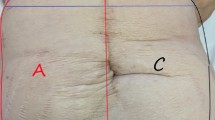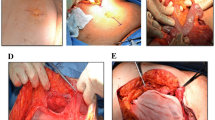Abstract
Background
Posterior component separation with transversus abdominis release technique is increasingly being used for abdominal wall reconstruction in complex abdominal wall repair. The main purpose of this study is to present a modification of the surgical technique originally described that facilitates the surgical procedure and offers additional advantages.
Methods
Based on the knowledge of the anatomy of the retromuscular space and the preperitoneal aerolar tissue distribution, we start the incision on the posterior rectus sheath from the arcuate line in a down to up direction. The posterior rectus sheath is incised 0,5–1 cm medial to the linea semilunaris and cut longitudinally as far as the fibers of transversus abdominis muscle that are divided in the superior part of the abdomen. It is also possible to avoid cutting the fibers of this muscle if we incise the posterior rectus sheath in an oblique direction to the midline from the umbilical area. Since 2012 to 2016, 69 consecutive patients with down to up TAR have been prospectively followed. Main outcome measures included demographics, perioperative details, wound complications, and recurrences.
Results
Between 2012 and 2016, we have operated 69 patients with down to up TAR technique. Mean operative time was 251 (range 65–566) minutes. Mean hospital stay was 9,8 (2–98) days. 10 patients presented surgical site events (14,5%): 6 patients had superficial site infection, 3 deep and 1 organ space. During follow-up, 3 patients (4,3%) presented incisional hernia recurrence.
Conclusions
This novel modification allows a simpler dissection of the preperitoneal retromuscular space and makes the TAR technique easier to perform. It also enables to incise only the insertion of the transversalis fascia cranially.






Similar content being viewed by others
References
Heller L, McNichols CH, Ramirez OM (2012) Component separations. Semin Plast Surg 26(1):25–28. https://doi.org/10.1055/s-0032-1302462
Cornette B, De Bacquer D, Berrevoet F (2017) Component separation technique for giant incisional hernia: a systematic review. Am J Surg 10 [Epub ahead of print]. https://doi.org/10.1016/j.amjsurg.2017.07.032.
de Vries Reilingh TS, van Goor H, Rosman C, Bemelmans MH, de Jong D, van Nieuwenhoven EJ, van Engeland MI, Bleichrodt RP (2003) “Components separation technique” for the repair of large abdominal wall hernias. J Am Coll Surg 196(1):32–37. https://doi.org/10.1016/S1072-7515(02)01478-3
Gibreel W, MG Sarr MR, Novitsky Y (2016) Technical considerations in performing posterior component separation with transverse abdominis muscle release. Hernia 20(3):449–459. https://doi.org/10.1007/s10029-016-1473-y
Liang MK, Holihan JL, Itani K, Alawadi ZM, Flores Gonzalez JR, Askenasy EP, Ballecer C, Sen Chong H, Goldblatt MI, Greenberg JA, Harvin JA, Keith JN, Martindale RG, Orenstein S, Richmond B, Roth JS, Szotek P, Towfigh S, Tsuda S, Vaziri K, Berge DH (2017) Ventral hernia management: expert consensus guided by systematic review. Ann Surg 265(1):80–89. https://doi.org/10.1097/SLA.0000000000001701
Holihan JL, Askenasy EP, Greenberg JA, Keith JN, Martindale RG, Roth JS, Mo J, Ko TC, Kao LS, Liang MK, the Ventral Hernia Outcome Collaboration Writing Group (2016) Component separation vs. bridged repair for large ventral hernias: a multi-institutional risk-adjusted comparison, systematic review, and meta-analysis. Surg Infect 17(1):17–26. https://doi.org/10.1089/sur.2015.124
Fox M, Cannon RM, Egger M, Spate K, Kehdy FJ (2013) Laparoscopic component separation reduces postoperative wound complications but does not alter recurrence rates in complex hernia repairs. Am J Surg 206(6):869–874. https://doi.org/10.1016/j.amjsurg.2013.08.005
Rives J, Pire JC, Flament JB, Polot JP (1987) Major incisional hernias. In: Chevrel JP (ed) Surgery of the abdominal wall. Springer-Verlag, New York, pp 116–144
Stoppa RE. The treatment of complicated groin and incisional hernias (1989) World JSurg 13(5):545–554.
CW Iqbal, TH Pham, A Joseph, J Mai, GB Thompson, MG Sarr (2007) Long-term outcome of 254 complex incisional hernia repairs using the modified rives-Stoppa technique World J Surg 31(12):2398–2404. doi: https://doi.org/10.1007/s00268-007-9260-7 .
EM Pauli , MJ Rosen. Open ventral hernia repair with component separation (2013) Surg Clin North Am 93(5):1111–1133. https://doi.org/10.1016/j.suc.2013.06.010 .
Carbonell AM, Cobb WS, Chen SM (2008) Posterior components separation during retromuscular hernia repair. Hernia 12(4):359–362. https://doi.org/10.1007/s10029-008-0356-2
YW Novitsky, HL Elliott, SB Orenstein, MJ Rosen (2012) Transversus abdominis muscle release: a novel approach to posterior component separation during complex abdominal wall reconstruction. Am J Surg 204(5):709–716. doi: https://doi.org/10.1016/j.amjsurg.2012.02.008.
NJ Slater AM, Berrevoet F, AM Carbonell AC, Franklin M, Kercher W, BJ Lammers EP-D, Rolls S, Towfigh S, van Greffen E, Conze J, van Goor H (2014) Criteria for definition of a complex abdominal wall hernia. Hernia 18(1):7–17. https://doi.org/10.1007/s10029-013-1168-6
FE Muysoms, M Miserez, F Berrevoet, G Campanelli, GG Champault, E Chelala, UA Dietz, HH Eker, I El Nakadi, P Hauters, M Hidalgo Pascual, A Hoeferlin, U Klinge, A Montgomery, RK Simmermacher, MP Simons, M Smietański, C Sommeling, T Tollens, T Vierendeels, A Kingsnorth (2009) Classification of primary and incisional abdominal wall hernias. Hernia 13(4):407–414. https://doi.org/10.1007/s10029-009-0518-x .
Ventral Hernia Working Group, K Breuing, CE Butler, S Ferzoco, M Franz, CS Hultman, JF Kilbridge, M Rosen, RP Silverman, D Vargo (2010) Incisional ventral hernias: review of the literature and recommendations regarding the grading and technique of repair. Surgery 148(3):544–558. https://doi.org/10.1016/j.surg.2010.01.008
SC Azoury, AP Dhanasopon, X Hui, SH Tuffaha, C De La Cruz, C Liao, M Lovins, HT Nguyen (2014) Endoscopic component separation for laparoscopic and open ventral hernia repair: a single institutional comparison of outcomes and review of the technique. Hernia18(5):637–645. https://doi.org/10.1007/s10029-014-1274-0 .
AM Carbonell, JA Warren, AS Prabhu, CD Ballecer, RJ Janczyk, J Herrera, LC Huang, S Phillips, MJ Rosen, BK Poulose (2017) Reducing length of stay using a robotic-assisted approach for retromuscular ventral hernia repair: a comparative analysis from the Americas hernia society quality collaborative. Ann Surg 27 [Epub ahead of print] https://doi.org/10.1097/SLA.0000000000002244.
P Patel, A Carbonell (2017) Laparoscopic and robotic incisional hernia repair. In: MA Garcia Ureña, J López Monclús, directors. Handbook of complex abdominal wall. Madrid (Spain): Grupo CTO Editorial. 49–57.
JH Ko, EC Wang, DM Salvay, Paul BC, Dumanian GA (2009) Abdominal Wall reconstruction lessons learned from 200 “components separation” procedures. Arch Surg 144(11):1047–1055. https://doi.org/10.1001/archsurg.2009.192.
DM Krpata , JA Blatnik, YW Novitsky, MJ Rosen (2012) Posterior and open anterior components separations: a comparative analysis. Am J Surg 203(3):318–322. https://doi.org/10.1016/j.amjsurg.2011.10.009 .
YW Novitsky , M Fayezizadeh, A Majumder, R Neupane, HL Elliott, SB Orenstein (2016) Outcomes of posterior component separation with transversus abdominis muscle release and synthetic mesh sublay reinforcement. Ann Surg 264(2):226–232. https://doi.org/10.1097/SLA.0000000000001673 .
De Silva GS, Krpata DM, Hicks CW, Criss CN, Gao Y, Rosen MJ, Novitsky YW (2014) Comparative radiographic analysis of changes in the abdominal wall musculature morphology after open posterior component separation or bridging laparoscopic ventral hernia repair. J Am Coll Surg 218(3):353–357. https://doi.org/10.1016/j.jamcollsurg.2013.11.014
Winder JS, Behar BJ, Juza RM, Potochny J, Pauli EM (2016) Transversus abdominis release for Abdominal Wall reconstruction: early experience with a novel technique. J Am Coll Surg 223(2):271–278. https://doi.org/10.1016/j.jamcollsurg.2016.04.012
Author information
Authors and Affiliations
Corresponding author
Ethics declarations
Conflict of interests
- Alvaro Robin-Lersundi: received honorarium for Gore for organizing workshops on abdominal wall surgery.
- Miguel-Angel García-Ureña: received honorarium for Gore for organizing workshops on abdominal wall surgery and has been an invited speaker in symposium organized by B. Braun.
- Luis Blaquez Hernando: received honorarium for Gore for organizing workshops on abdominal wall surgery.
- Javier López-Monclús: received honorarium for Gore for organizing workshops on abdominal wall surgery.
- Arturo Cruz Cidoncha: declares no conflict of interest.
- Carlos San Miguel: declares no conflict of interest.
- Elena Jimenez Cubedo: declares no conflict of interest.
Ethical approval
This article does not contain any studies with animals performed by any of the authors.
All procedures performed in this study with human participants were in accordance with the ethical standards of the institutional and/or national research committee and with the 1964 Helsinki declaration and its later amendments or comparable ethical standards.
Informed consent
Informed consent was obtained from all individual participants included in the study.
Rights and permissions
About this article
Cite this article
Robin-Lersundi, A., Blazquez Hernando, L., López-Monclús, J. et al. How we do it: down to up posterior components separation. Langenbecks Arch Surg 403, 539–546 (2018). https://doi.org/10.1007/s00423-018-1655-4
Received:
Accepted:
Published:
Issue Date:
DOI: https://doi.org/10.1007/s00423-018-1655-4




